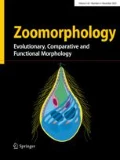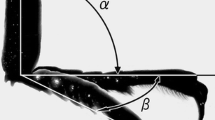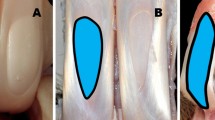Summary
Representatives of all avian orders were studied in order to establish that the tendon-locking mechanism (TLM), consisting of local specialization of the flexor tendons and the adjacent portion of the flexor tendon sheath, is by no means rare, but rather, constitutes the prevalent condition in a large majority of the avian species sampled. The areas of tubercles on the tendons and the adjacent sheath plications intermesh with one another thereby forming a true tendon-locking mechanism that maintains the distal and other interphalangeal joints of the digits in the flexed position. The TLM seems to function not only in perching, but in a wide variety of other activities of the avian foot including swimming, wading, prey-grasping, clinging, hanging, and tree climbing. The basic structural components of the mechanism are remarkably similar in the divergent avian groups adapted for these activities. Ultrastructural detail of the TLM was studied by means of scanning and transmission electron microscopy. Interdigital variation in distribution of the TLM in all of the digits of individuals were made as were comparisons of the interspecific distribution of the TLM. An analysis of the biomechanics involved in engaging the elements of the TLM and how they produce locking of the flexed joints of the digits includes a consideration of the roles of the podothecal pads, ungual flexor processes, and the elastic flexor and extensor ligaments of the toes. The components of the TLM are differentiated in early fetal development establishing that the TLM components are not acquired adventitiously in response to such factors as posthatching mechanical stresses.
Similar content being viewed by others
References
Baumel JJ, King AS, Lucas AM, Breazile JE, Evans HE (eds) (1979) Nomina Anatomica Avium, an annotated dictionary of birds. London New York, Academic Press
Beckham C, Greenlee TK (1975) Chick vincula: elastic structures with a check-rein mechanism. J Anat 119 (2):295–308
Bent AC (1940) Life histories of North American goatsuckers, Hummingbirds and Their Allies, Washington, US Govt Printing Office, pp 147–252
Bent AC (1963) Life histories of North American marsh birds. New York, Dover Publ, pp 356–366
Berger AJ (1966) The musculature. In: George JC, Berger AJ (eds) Avian myology. New York, London, Academic Press, pp 224–473
Bock WJ (1965) Experimental analysis of the avian passive perching mechanism. Am Zool (5):681
Cracraft J (1971) The functional morphology of the hind limb of the domestic pigeon, Columba livia. Bull Am Mus Nat Hist 144(3):173–268
Cramp S (ed) (1977) Handbook of the birds of Europe, the Middle East, and North Africa, vol 1. Oxford, Oxford Univ Press, pp 78–88
Goslow GE (1972) Adaptive mechanisms of the raptor pelvic limb. Auk 89:47–64
Hudson GE (1937) Studies on the muscles of the pelvic appendage in birds. Am Midl Nat 18:1–108
Lennerstedt I (1975) A functional study of papillae and pads in the foot of passerines, parrots, and owls. Zool Scr 4:111–123
Lucas AM, Stettenheim PR (1972) Avian anatomy: Integument, Part I. Washington, US Govt Printing Office, pp 69–71
Morony JJ, Bock WJ, Farrand J (1975) Reference list of the birds of the World. New York, Am Mus Nat Hist
Quinn TH, Baumel JJ (1983) An SEM study of a locking mechanism on avian pedal flexor tendons. Anat Rec 205(3):156A
Raikow RJ (1970) Evolution of diving adaptations in the stifftail ducks. Univ Calif Berkeley Publ Zool 94:1–52
Raikow RJ (1973) Locomotor mechanisms in North American ducks. Wilson Bull 85:295–307
Raikow RJ (1978) Appendicular myology and relationships of the New World nine-primaried oscines. Bull Carneg Mus Nat Hist 7:1–43
Raikow RJ (1985) Locomotor System. In: King AS, McLelland J (eds) Form and function in birds, vol 3. London-New York, Academic Press, pp 57–147
Ranvier LA (1889) Sur les tendons des doigts chez les oiseaux. CR Acad Sci Paris 13:167–169
Richardson F (1942) Adaptive modifications for tree-trunk foraging birds. Univ Calif Berkeley Publ Zool 317–378
Schaffer J (1903) Über die Sperrvorrichtung an den Zehen der Vögel. Z Wiss Zool 73:377–428
Schaffer J (1905) Anatomisch-histologische Untersuchungen über den Bau der Zehen bei Fledermäusen und einigen kletternden Säugetieren. Z Wiss Zool 83:231–284
Scharnke H (1930) Physiologisch-anatomische Studien am Fuss der Spechte. J Ornithol 78(3):308–327
Shepherd JD (1981) An analysis of proposed avian perching mechanisms. Thesis, University of Connecticut Diss Abstr Int B 41(9):3352
Stolpe M (1932) Physiologisch-anatomische Untersuchungen über die hintere Extremität der Vögel. J Ornithol 80(2):161–247
Storer RW (1960a) The fossil loon Colymboides minutus. Condor 58:413–426
Storer RW (1960b) Evolution in diving birds. Proc Int Ornithol Congr 12:694–707
Watson M (1869) On the mechanisms of perching in birds. J Anat 3:379–384
Author information
Authors and Affiliations
Rights and permissions
About this article
Cite this article
Quinn, T.H., Baumel, J.J. The digital tendon locking mechanism of the avian foot (Aves). Zoomorphology 109, 281–293 (1990). https://doi.org/10.1007/BF00312195
Received:
Issue Date:
DOI: https://doi.org/10.1007/BF00312195




